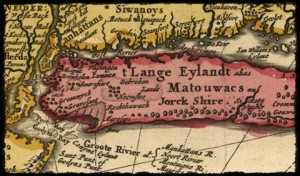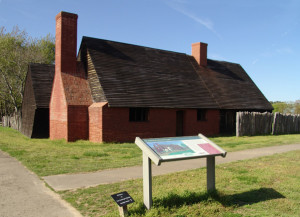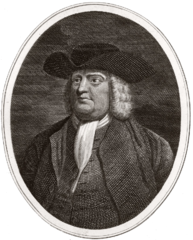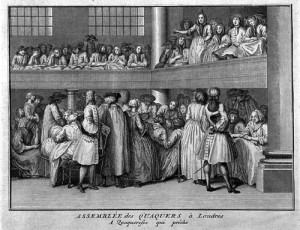1640 -1710
New Netherland and Pennsylvania
Many Faiths
When the Puritans arrived in John Winthrop’s fleet on the shores of Massachusetts in 1630, a great migration of Europeans to the America began and continued with remarkable force into the second half of the seventeenth century. Immigrants of Dutch, Welsh and German origin as well as members of the Puritan, Calvinist, and Lutheran religions arrived in North America seeking refuge from poverty and religious persecution. Many of Mother’s ancestors were among these refugees of many cultures and faiths who gathered together in the new American colonies.
New Netherland, a colony founded by Dutch entrepreneurs along the Hudson River about 1624 was short-lived and vanished when the English wrested control of it in 1664 turning its capital, New Amsterdam, into New York City. Nevertheless it left a culture infused with old world customs and Protestant beliefs. Gerret van Sweringen, a well-educated son of a Dutch nobleman, came to America in 1657 as an agent for the City of Amsterdam. Having lived through a ship-wreck during his arrival in New Amsterdam he later lost his entire estate when the English invaded and captured the Dutch Colony. He then moved to St. Mary’s City in the Roman Catholic colony of Maryland where he was soon appointed an alderman and became proprietor of an ordinary (a type of inn with a tavern).
This inn, “the most elegant establishment in Maryland”, was the meeting place for the Governors Council and much of his trade came from those who traveled to the capital city on official business. Van Sweringen’s Inn has since been reconstructed as part of Historic St. Mary’s City.
In 1755 Van Sweringen’s great granddaughter Roseanne Sweringen married John Burcham, a direct descendant of the immigrant Quaker James Burcham who vehemently opposed the Revolutionary War at the time of Lexington and Concord. This Quaker family is in the line of Mary Johnson, Mother’s maternal grandmother.
Quakers
In 1677 a group of prominent Quakers led by William Penn had been granted the colonial province of West Jersey, half of the current state of New Jersey. That same year Penn drafted a charter of liberties for the settlement which guaranteed free and fair trial by jury, freedom of religion, freedom from unjust imprisonment and free elections. This pact attracted many families who were troubled with the Anglican Church and dissatisfied with what they perceived as an incomplete break from the Roman Catholics.
The Quakers (also known as the Religious Society of Friends) came from the lower middle class of English society. They were farmers, craftsmen, laborers, and servants. Their Quaker view of the Bible was different. They had no formal doctrine, no formal worship service, no ordained ministers, and they were adamantly opposed to war. They had a highly organized system of meetings and record keeping which has provided much important information for genealogists. The Quakers also had a strict set of marriage customs. Quakers were not allowed to marry non-Quakers “under pain of excommunication.” One of Mother’s Quaker ancestors, Jemimah Hiatt, was disowned for this very reason when she married Charles Johnson in 1844.
There were several Quaker families in Mother’s ancestry including Richard Lundy. He had arrived in Massachusetts in 1676 and then fled from the Puritans to West Jersey. Four generations later, his descendant, Jemimah Lundy, married William Hiatt. The Hiatt family originated in Wales and came to America in about 1678. The Quakers embraced William Penn’s humanitarian principles and joined the great flow of immigrants who took advantage of the religious tolerance and the land opportunities in the colonies. Eventually the Hiatts settled in Penn’s new colony of Pennsylvania. The Hiatt and Lundy immigrants gradually merged and migrated from West Jersey and Pennsylvania to Virginia and Carolina following the coastline trails from New England. Along the way these Quaker families established Society of Friends’ Meetings as they settled in new homes. The families were joined when Jemimah Lundy married William Hiatt in 1806.
These Quaker families were among the earliest European settlers in the American Colonies. After enduring poverty and persecution in their former homelands, they came to America to face the hardships and the immense task of building new settlements in the American wilderness. These families and their descendants had to be very determined and hardy to live and thrive as pioneers, and Mother’s pioneer ancestors were no exception. Jemimah Lundy Hiatt, Mother’s 2nd great grandmother, was part of a group of families who decided to leave the slavery culture of North Carolina in the early 1800s to find new homes in the recently opened Northwest Territory which included the future states of Ohio and Indiana. These families probably traveled by river in Carolina, by pack animal and on foot across the Cumberland Gap, and then eventually by wagon to Indiana. According to family lore, Jemimah was one hundred years old when she died! A Hiatt family genealogist relates that Jemimah had been born in New Jersey, had married in Virginia, and before she died in Indiana had become the mother of nineteen children, seventeen of whom had lived to adulthood!
The Dutch Reformed Church
 As the colony of New Netherlands was being settled by Dutch beginning about 1630 they founded the Dutch Reformed Church and from their detailed records we find some familiar sounding places which were originally named by the New Netherlands Dutchmen: Lang Eylant (Long Island), Breuckelen (Brooklyn), Haarlem, and Staten Eylant (Staten Island). These records also reveal a number of interesting person names which are often confusing because of their many variations. The patronymic names were spelled in many ways, often in the same family. It was also the custom to refer to a person by mentioning his given name along with the first name of his father. For instance, Jan Thomasse would mean John the son of Thomas, and Jan Janse would mean John the son of John. To such a name could be added another one which indicated generally the place from which he came; VanDyke was the man of the dike who had probably lived in Dutch towns known by that name.
As the colony of New Netherlands was being settled by Dutch beginning about 1630 they founded the Dutch Reformed Church and from their detailed records we find some familiar sounding places which were originally named by the New Netherlands Dutchmen: Lang Eylant (Long Island), Breuckelen (Brooklyn), Haarlem, and Staten Eylant (Staten Island). These records also reveal a number of interesting person names which are often confusing because of their many variations. The patronymic names were spelled in many ways, often in the same family. It was also the custom to refer to a person by mentioning his given name along with the first name of his father. For instance, Jan Thomasse would mean John the son of Thomas, and Jan Janse would mean John the son of John. To such a name could be added another one which indicated generally the place from which he came; VanDyke was the man of the dike who had probably lived in Dutch towns known by that name.
Jan Thomasse VanDyke arrived from Amsterdam in 1652 and was one of the founders of New Utrecht, where Director-General Peter Stuyvesant had permitted the establishment of a town comprising about one thousand acres divided into farms. VanDyke owned one of these farms and in 1759 added to it a tract of meadow land near what is now called Coney Island. For many years he was Magistrate of Fort Orange and New Utrecht, known now as Albany and Brooklyn. His great granddaughter Mary Elizabeth became the wife of Jacob Wimmer (1762) whose ancestors had been refugees from the Palatine in Germany in 1710. This marriage merged Dutch Reformed Church families and German Lutheran families from Holland and Germany. VanDyke was the immigrant whose descendants led to Martha Wimmer, Mother’s paternal great grandmother.
German Palatine Lutherans
In Europe the political turmoil fueled by the Thirty Years War 1618-1648 brought about the frequent change of government rulers. The rulers chose what church they wanted in their lands, and many pious Germans with their own strong convictions found this hard to bear. The Wimmers came to America from Germany during that time. Johannes Wimmer arrived with his widowed mother in New York about 1710 having come with a group of German Palatine refugees. They were Lutherans, and their Wimmer name suggests that the family had been wine makers or they cultivated the vineyards. The Germans merged with the Dutch when Johannes Wimmer married Wyntje Simonson 2nd great granddaughter of Dutch immigrant Barent Simonson who had immigrated more than fifty years earlier.
Jacob Wimmer, their grandson, came into the Ohio Territory as one of the earliest ancestors in Christopher Parker’s family line to migrate west of the Appalachian Mountains. We know that he purchased land in Butler County near the boundary of Indiana, reared a family and died a man of goodly means as evidenced by his will:
In the name of God, Amen, I Jacob Wimmer of the Township of Oxford, County of Butler, State of Ohio, being of sound mind and memory, but weak of body, do make this my last will and Testament hereby revoking all former or other wills by me heretofore made. I give and bequeath unto my son Abraham two dollars and to my son John two dollars and to my son Jacob two dollars. There is two hundred and fifty dollars remaining in the hands of son Jacob which I also bequeath in manner following viz to my daughter Sarah fifty dollars, and to my daughter Martha one dollar, to my daughter Rachel one hundred dollars and to my daughter Mary one hundred dollars, all to be paid in Virginia currency. Consequently two hundred pounds or six hundred and sixty-six dollars sixty six mills that remain in the hands of William Eakers which I bequeath as follows, to my daughter Sarah fifty dollars and no interest, to my daughter Rachel three hundred and eight dollars thirty three cents three mills, to my daughter Mary three hundred and eight dollars thirty three cents three mills all to be pai
d in Virginia currency. I also bequeath unto my daughter Rachel one Rifle gun one drawing knife. Also to my daughter Mary one hand ax one cooper adds and turning tools one taper auger one screw auger one calf one jack plain one jointer one smoothing plain. I also bequeath to Quartis Moore one fifteen dollar note against Thomas Davidson, one note for fifty bushels of wheat against Thomas Davidson and I do by these presents declare and publish the above to be my last will and testament and do hereby constitute and nominate and appoint my trusty friend Quartis Moor and David Baiers to be my Executors of this my last Will and Testament. Witness my hand and seal the first day of March 1822.
Jacob’s son Abraham Wimmer married Susannah Lemmon whose grandfather, John Christian Lehman, had arrived in Philadelphia on the ship “Thistle of Glasgow” in 1730 among a group of Pietist Germans who had broken from the Lutheran Church and became known as the Dunkards, or by their American name of Baptists. However, John Christian probably was not a Baptist since he was buried in the Lutheran cemetery in Frederick, Maryland. The name Lehman in German meant “vassal” or one who worked the land and who was attached for life to a particular piece of property and its owner. As was common many different spellings of the name appeared in various records.
Abraham Wimmer and Susannah Lemmon continued their westward migration to Sangamon County, Illinois where they died and are buried in the Wimmer Cemetery. Jacob’s daughter Martha married Abraham Parker in Preble County Ohio in 1823 and his grandson Christopher Parker married Mary Johnson in Kosciusko County, Indiana in 1863 merging the Carolina Quaker ancestors with Pennsylvania Germans. About 1870 they moved to Lee County, Illinois. Christopher’s brother Ephraim and Mary’s sister Rachael married and also moved to Illinois where they all lived to the end of their days.




